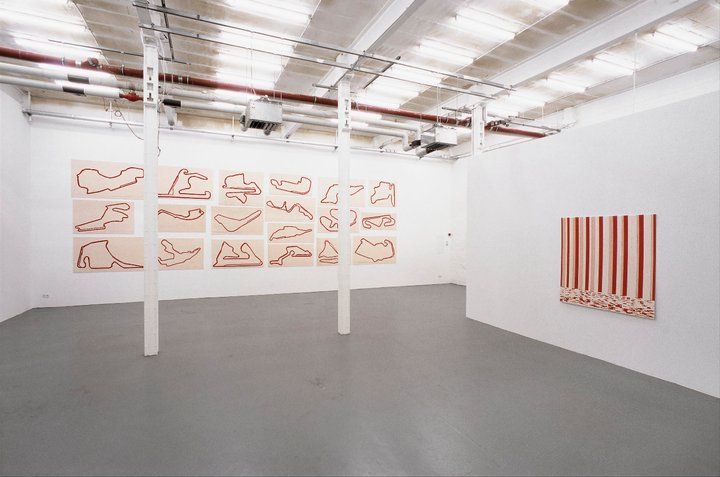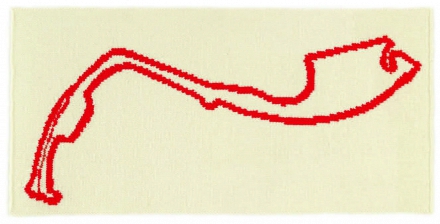
Bea Meyer thematizes in her exhibition RED/WHITE/HOCKEN/HEIM two quite divergent areas of social life which are closely interwoven with prejudices and clichéd concepts: Formula One Motor Racing and breastfeeding. On the one hand, Meyer presents the ground plans of all nineteen Formula One racetracks, from Australia through Germany all the way to Brazil. She takes up the abstract forms of the racetracks and through this juxtaposition depicts their diverse progressions, which she translates into knitted images. The routes are knitted with red wool and surrounded by a natural white background. Meyer uses knitting for another purpose, producing not sweaters or mittens but instead pictures whose formal quality reveals them to be independent commentaries and creations within an artistic context. She transfers the coordinates of a sport reserved exclusively for men onto a terrain designated in the widest sense as belonging to women. In the large number of pictures, it becomes clear how limited is the freedom to maneuver during the race, how narrow and prescribed is the competitive sequence. The circuit becomes a knitted pattern. The other pictures of her exhibition are based on breastfeeding transcripts. For the viewer, however, this special context scarcely becomes apparent. What may be seen instead is an abstract pattern which suggests conceptual or minimalist processes of pictorial invention, but not an intimate personal transcript of the breastfeeding behavior of a child. Even though Meyer documents a private and intimate domain, nonetheless she never allows the personal aspect to become exhibitionistic. At the same time, she demolishes the myth of a forced harmony between mother and child, inasmuch as she selects a cool and distanced representational procedure and presents breastfeeding in terms of statistics which are subject to a series of intense oscillations. In both series of works, Meyer accomplishes a revelation of the fundamental structures and possible contradictions, ossifications and absurdities inherent to the respective procedures. Whereas the racetracks are presented en miniature and only in this reduction of scale permit the aforementioned analysis, form and contents are enlarged and abstracted in the breastfeeding transcripts to the point where a fundamental discussion becomes possible here as well. Bea Meyer demonstrates the degree to which all protagonists, independently of their social and communal status, are caught in the endless loop of their assigned roles. The technique of artistic transfer and representation plays a central role in the work of Bea Meyer. She contrasts, reworks and interprets the various materials both precisely and subtly. The artist succeeds in putting into question the preexisting significatory levels of certain materials and types of utilization without ever arguing in a stereotypical or clichéd manner. In the current exhibition, the transposition into a conceptual, geometrical style of painting or into knitted images, is free from all expressive aspects and, above all, investigates a procedure of technical reproduction in terms of its aesthetic qualities. Meyer cleverly interchanges the rational and emotional elements and shifts the clearly delineated front lines laid out between masculine and feminine positions. By means of her clear formulation both of this autobiographical background and, not least of all, of the specific conditions surrounding the social role assigned to women, along with her consummate mastery of the formal challenges offered by the material, Bea Meyer is able to achieve an intense confrontation with her thematic contents in a dynamic field emanating between the poles of artistic work and social commentary.
Maik Schlüter, critic and curator, Braunschweig
VG-Wort, Bonn 2006











